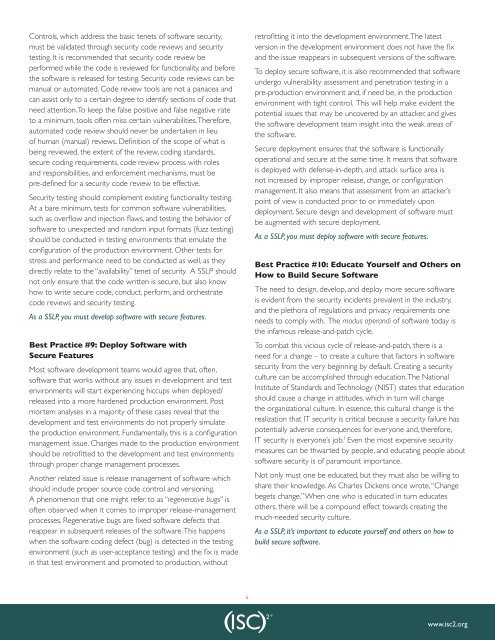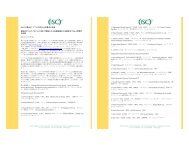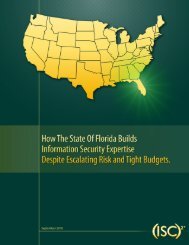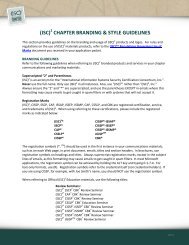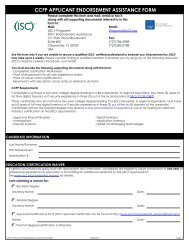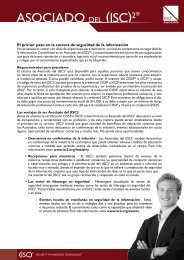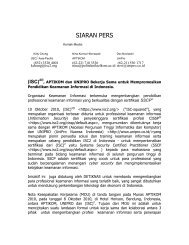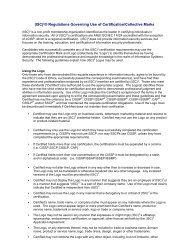The Ten Best Practices for Secure Software Development - ISC
The Ten Best Practices for Secure Software Development - ISC
The Ten Best Practices for Secure Software Development - ISC
Create successful ePaper yourself
Turn your PDF publications into a flip-book with our unique Google optimized e-Paper software.
Controls, which address the basic tenets of software security,<br />
must be validated through security code reviews and security<br />
testing. It is recommended that security code review be<br />
per<strong>for</strong>med while the code is reviewed <strong>for</strong> functionality, and be<strong>for</strong>e<br />
the software is released <strong>for</strong> testing. Security code reviews can be<br />
manual or automated. Code review tools are not a panacea and<br />
can assist only to a certain degree to identify sections of code that<br />
need attention. To keep the false positive and false negative rate<br />
to a minimum, tools often miss certain vulnerabilities. <strong>The</strong>re<strong>for</strong>e,<br />
automated code review should never be undertaken in lieu<br />
of human (manual) reviews. Definition of the scope of what is<br />
being reviewed, the extent of the review, coding standards,<br />
secure coding requirements, code review process with roles<br />
and responsibilities, and en<strong>for</strong>cement mechanisms, must be<br />
pre-defined <strong>for</strong> a security code review to be effective.<br />
Security testing should complement existing functionality testing.<br />
At a bare minimum, tests <strong>for</strong> common software vulnerabilities,<br />
such as overflow and injection flaws, and testing the behavior of<br />
software to unexpected and random input <strong>for</strong>mats (fuzz testing)<br />
should be conducted in testing environments that emulate the<br />
configuration of the production environment. Other tests <strong>for</strong><br />
stress and per<strong>for</strong>mance need to be conducted as well, as they<br />
directly relate to the “availability” tenet of security. A SSLP should<br />
not only ensure that the code written is secure, but also know<br />
how to write secure code, conduct, per<strong>for</strong>m, and orchestrate<br />
code reviews and security testing.<br />
As a SSLP, you must develop software with secure features.<br />
<strong>Best</strong> Practice #9: Deploy <strong>Software</strong> with<br />
<strong>Secure</strong> Features<br />
Most software development teams would agree that, often,<br />
software that works without any issues in development and test<br />
environments will start experiencing hiccups when deployed/<br />
released into a more hardened production environment. Post<br />
mortem analyses in a majority of these cases reveal that the<br />
development and test environments do not properly simulate<br />
the production environment. Fundamentally, this is a configuration<br />
management issue. Changes made to the production environment<br />
should be retrofitted to the development and test environments<br />
through proper change management processes.<br />
Another related issue is release management of software which<br />
should include proper source code control and versioning.<br />
A phenomenon that one might refer to as “regenerative bugs” is<br />
often observed when it comes to improper release-management<br />
processes. Regenerative bugs are fixed software defects that<br />
reappear in subsequent releases of the software. This happens<br />
when the software coding defect (bug) is detected in the testing<br />
environment (such as user-acceptance testing) and the fix is made<br />
in that test environment and promoted to production, without<br />
6<br />
retrofitting it into the development environment. <strong>The</strong> latest<br />
version in the development environment does not have the fix<br />
and the issue reappears in subsequent versions of the software.<br />
To deploy secure software, it is also recommended that software<br />
undergo vulnerability assessment and penetration testing in a<br />
pre-production environment and, if need be, in the production<br />
environment with tight control. This will help make evident the<br />
potential issues that may be uncovered by an attacker, and gives<br />
the software development team insight into the weak areas of<br />
the software.<br />
<strong>Secure</strong> deployment ensures that the software is functionally<br />
operational and secure at the same time. It means that software<br />
is deployed with defense-in-depth, and attack surface area is<br />
not increased by improper release, change, or configuration<br />
management. It also means that assessment from an attacker’s<br />
point of view is conducted prior to or immediately upon<br />
deployment. <strong>Secure</strong> design and development of software must<br />
be augmented with secure deployment.<br />
As a SSLP, you must deploy software with secure features.<br />
<strong>Best</strong> Practice #10: Educate Yourself and Others on<br />
How to Build <strong>Secure</strong> <strong>Software</strong><br />
<strong>The</strong> need to design, develop, and deploy more secure software<br />
is evident from the security incidents prevalent in the industry,<br />
and the plethora of regulations and privacy requirements one<br />
needs to comply with. <strong>The</strong> modus operandi of software today is<br />
the infamous release-and-patch cycle.<br />
To combat this vicious cycle of release-and-patch, there is a<br />
need <strong>for</strong> a change – to create a culture that factors in software<br />
security from the very beginning by default. Creating a security<br />
culture can be accomplished through education. <strong>The</strong> National<br />
Institute of Standards and Technology (NIST) states that education<br />
should cause a change in attitudes, which in turn will change<br />
the organizational culture. In essence, this cultural change is the<br />
realization that IT security is critical because a security failure has<br />
potentially adverse consequences <strong>for</strong> everyone and, there<strong>for</strong>e,<br />
IT security is everyone’s job. f Even the most expensive security<br />
measures can be thwarted by people, and educating people about<br />
software security is of paramount importance.<br />
Not only must one be educated, but they must also be willing to<br />
share their knowledge. As Charles Dickens once wrote, “Change<br />
begets change.” When one who is educated in turn educates<br />
others, there will be a compound effect towards creating the<br />
much-needed security culture.<br />
As a SSLP, it’s important to educate yourself and others on how to<br />
build secure software.<br />
www.isc2.org


